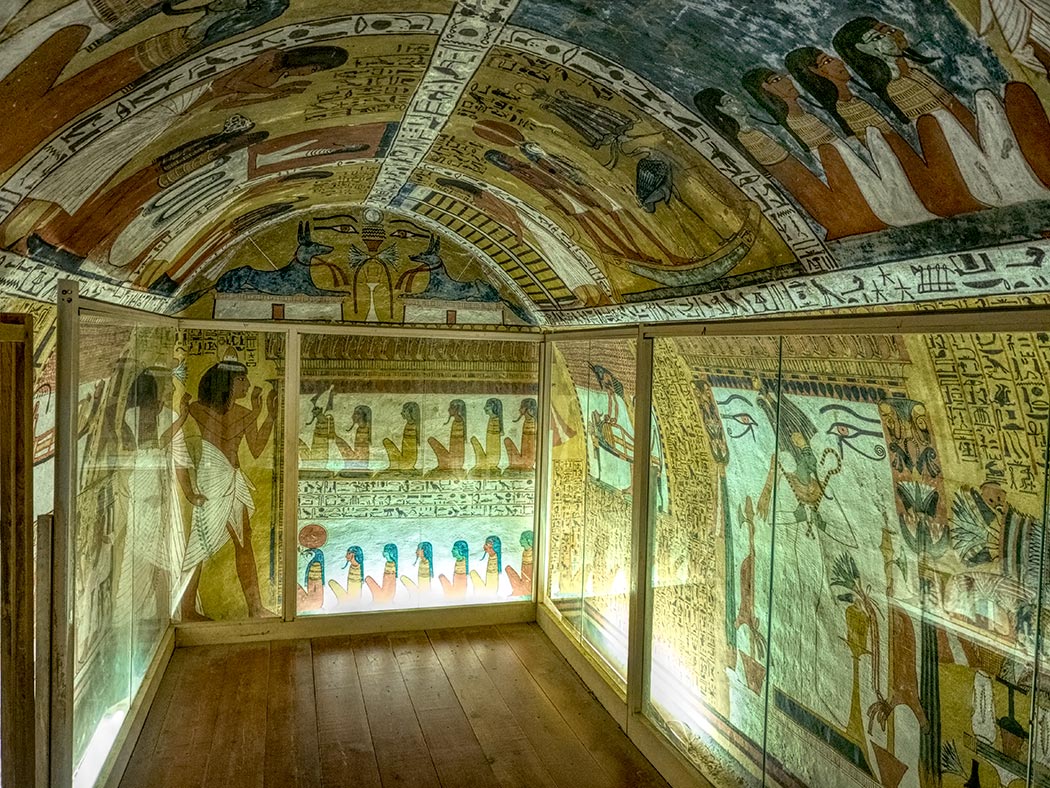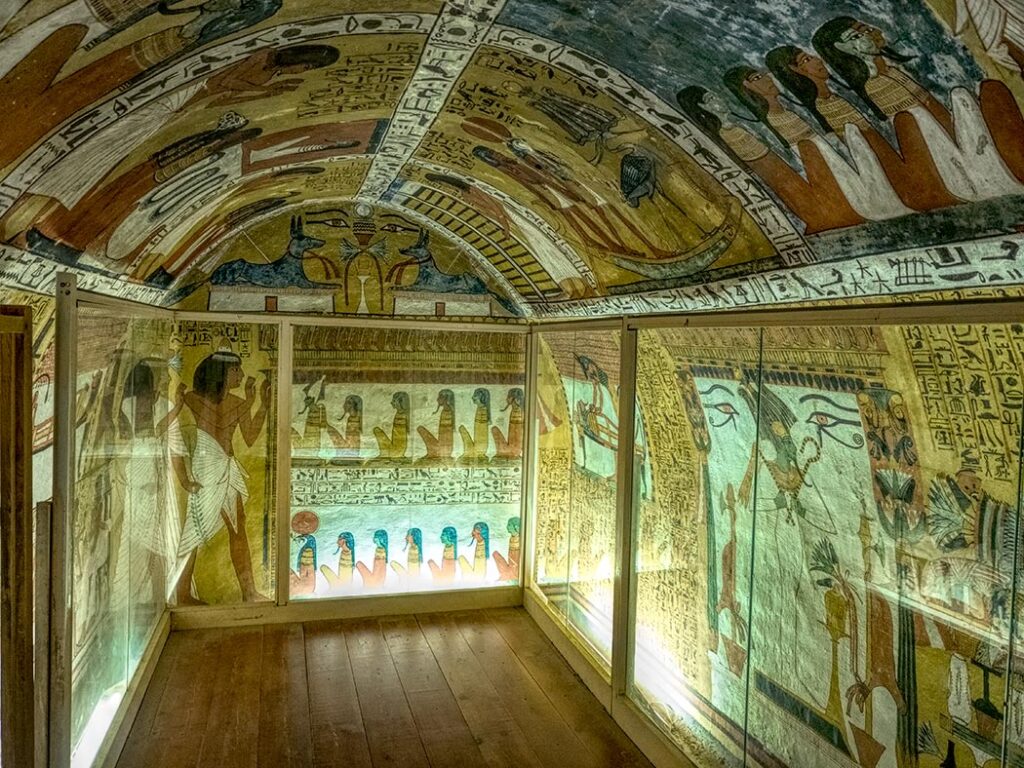Introduction to Sin Negm Cemetery
Emplacement and Historical Context
La tombe de Sin Negm se trouve dans le cimetière ouest de Deir el-Médineh et est désignée sous le numéro Nott1. C'est l'une des tombes égyptiennes les mieux conservées. Sin Negm vécut durant la XIXe dynastie, sous le règne du pharaon Séthi Ier et les premières années de Ramsès II.
Who Was Sin Negm – Roles and Titles in Ancient Egypt
Sin Negm held the title of “Servant in the Place of Truth,” a common title for the workers and craftsmen who built and decorated the royal tombs in the Valley of the Kings. He likely died in the 11th year of Ramses II’s reign. His tomb was discovered on February 2, 1886, and is considered one of the most complete and perfectly preserved family tombs. Around 20 mummies were found inside, including Sin Negm, his wife, children, and a young girl named Hathor.
Tomb Architecture and Artistry
Unique Wall Paintings and Religious Symbolism
The tomb’s chamber is adorned with vivid decorations and colorful paintings on a yellow background. The vibrant palette includes chalk white, black, red, yellow, lapis lazuli, and turquoise blue. The scenes reflect agricultural life in the afterlife and religious beliefs, featuring Sin Negm and his wife planting, harvesting, and offering to the gods.
Structure and Layout of the Burial Chambers
The tomb comprises four main parts: an upper courtyard with a small pyramid, a 6-meter-deep shaft, and a sequence of rock-cut rooms ending in a vaulted burial chamber. The chamber is around 5 by 2.5 meters in size with a 2.5-meter-high ceiling, lined with mud bricks, plaster, and red stucco.
Archaeological Discoveries and Significance
Excavation History and Findings
The tomb was uncovered by Egyptian workers in 1886. It revealed approximately nine coffins in pristine condition, along with numerous burial artifacts that provided valuable insight into 19th Dynasty funerary customs.
Importance in Understanding Noble Life During the New Kingdom
As a “Servant in the Place of Truth,” Sin Negm was among the skilled artisans of Deir el-Medina, a community essential to building royal tombs. His burial site offers scholars a deeper understanding of daily life, craftsmanship, and religious beliefs among Egypt’s middle class.
Visiting Sin Negm Cemetery in 2025
Travel Tips and Access Information
Located in Deir el-Medina near Luxor’s west bank, the site is accessible via guided tours. Visitors are encouraged to visit in the morning and wear comfortable walking shoes due to uneven terrain.
Nearby Attractions in the Valley of the Nobles
Close to Sin Negm’s tomb are several other notable sites, including the Tomb of Sennedjem and the Temple of Hathor at Deir el-Medina. These attractions offer a comprehensive view of life and death during ancient Egypt’s New Kingdom period.
Preservation and Cultural Heritage
Restoration Efforts and Protection Measures
The tomb has undergone multiple conservation efforts to preserve its vivid artwork and structural integrity. Protective measures are in place to limit environmental damage and visitor impact.
The Role of Sin Negm Cemetery in Egyptology Today
Sin Negm’s tomb remains a valuable educational and cultural resource. Egyptologists continue to study its art, inscriptions, and burial customs to deepen our understanding of 19th Dynasty society.
Additional Paragraph (200 words):
The significance of Sin Negm’s tomb extends beyond its artistic and architectural brilliance. It serves as a rare window into the lives of those who worked behind the scenes in the creation of the grand royal tombs. Unlike the lavish burials of kings and high priests, Sin Negm’s tomb reveals the personal and spiritual life of a middle-class artisan in New Kingdom Egypt. His role as a “Servant in the Place of Truth” highlights the prestige and trust placed upon the craftsmen of Deir el-Medina.
The scenes
The scenes painted on his tomb walls not only illustrate beliefs in the afterlife but also reflect daily agricultural tasks, family values, and the enduring hope of eternal peace. The detail in the artwork suggests a personal touch—possibly by Sin Negm himself or his close colleagues—further deepening the connection between the deceased and the work they left behind. Today, the tomb is a powerful symbol of Egypt’s rich cultural fabric, reminding visitors that even the most modest of citizens could achieve a form of immortality through their devotion and artistry. Exploring Sin Negm’s final resting place offers a quiet, intimate glimpse into a forgotten chapter of Egypt’s glorious past.


